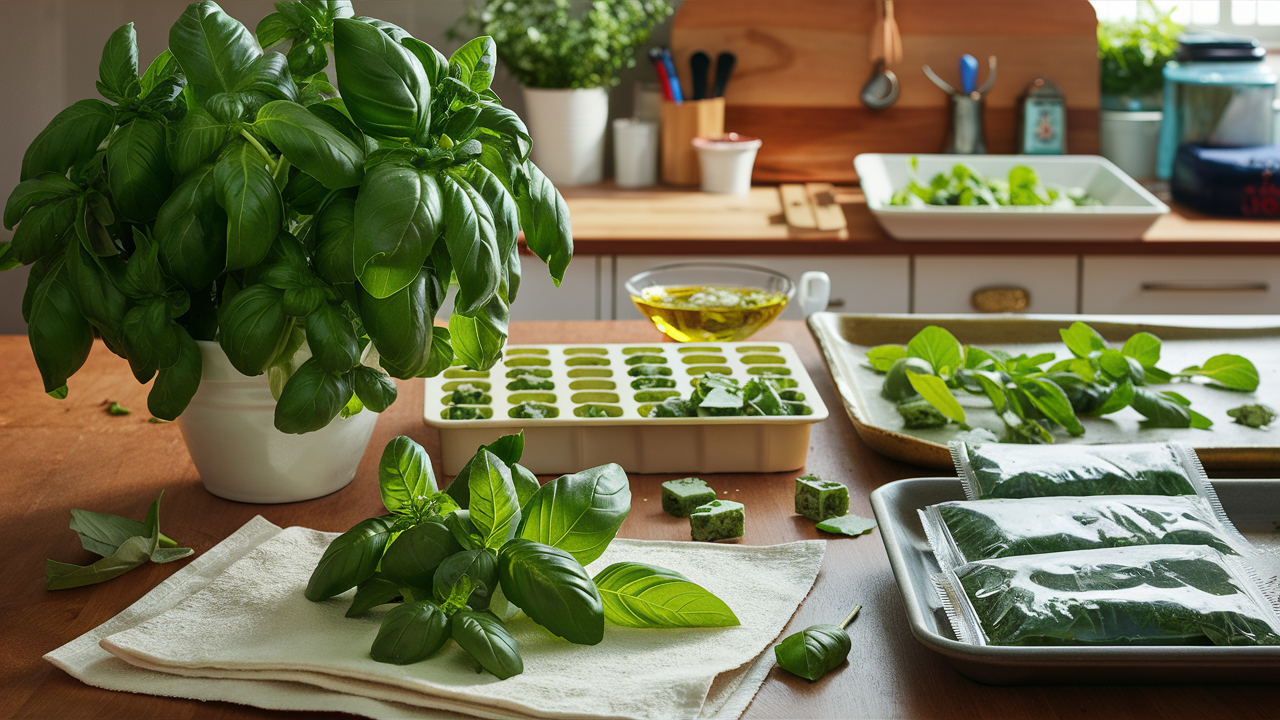Basil is one of those herbs that instantly elevates a dish, whether it’s a simple pasta, a refreshing salad, or a fragrant curry. But if you’ve ever bought or grown basil, you know how quickly those delicate leaves can go from vibrant green to sad and wilted. The good news? You don’t have to watch your basil go to waste. Freezing basil is a simple and effective way to preserve its flavor and aroma for months.
Whether you’re working with a bounty from your garden or just trying to save the last few sprigs from the fridge, this guide will walk you through the best methods for freezing basil so it stays fresh and flavorful.
Why Freeze Basil?
Fresh basil is amazing, but it’s also incredibly perishable. Freezing allows you to:
- Avoid Waste: Don’t toss those extra leaves—freeze them for later.
- Save Money: Basil can be pricey, especially out of season. Freezing helps you make the most of what you have.
- Convenience: Frozen basil is a quick, easy way to add flavor to your dishes without running to the store.
While freezing changes the texture of basil (making it less ideal for garnishing), the flavor remains intact, making it perfect for cooking.
Prepping Basil for Freezing
Before you start freezing, it’s important to prep your basil properly.
Step 1: Harvest or Buy Fresh Basil
If you’re harvesting from your garden, pick basil early in the morning when the leaves are at their freshest. If you’re using store-bought basil, try to freeze it as soon as possible to preserve its quality.
Step 2: Wash and Dry
Rinse the basil leaves gently under cool water to remove dirt or residue. Pat them dry with a clean towel or use a salad spinner to get rid of excess moisture. Proper drying is key—too much water can lead to freezer burn.
Step 3: Remove the Stems
Pluck the leaves from the stems. You can freeze the stems separately if you’d like (they’re great for adding flavor to broths and soups).
The Best Methods for Freezing Basil
There’s more than one way to freeze basil, and the right method depends on how you plan to use it later.
Method 1: Freezing Whole Leaves
If you want to preserve the leaves in their natural form, this is the way to go.
- Lay the dried basil leaves in a single layer on a baking sheet.
- Place the baking sheet in the freezer and flash freeze the leaves for about 2 hours.
- Once frozen, transfer the leaves to a freezer-safe bag or container.
- Label the bag with the date and store it in the freezer.
Best For: Dishes where you’ll cook the basil, like soups, stews, or sauces.
Method 2: Freezing Basil in Oil
This method is perfect for creating ready-to-use flavor bombs for your recipes.
- Chop the basil leaves finely or leave them whole if you prefer.
- Fill the compartments of an ice cube tray about halfway with basil.
- Cover the basil with olive oil (or another neutral oil) until the compartments are full.
- Freeze the tray until the cubes are solid (about 4-6 hours).
- Pop the cubes out and store them in a freezer-safe bag or container.
Best For: Sautéing, pasta sauces, or any dish where you’d normally start with oil and herbs.
Method 3: Making Basil Paste
Basil paste is a versatile option that’s especially handy for making pesto, soups, or marinades.
- Blend the basil leaves with a small amount of olive oil in a food processor until it forms a smooth paste.
- Spoon the paste into an ice cube tray or small freezer-safe containers.
- Freeze until solid, then transfer to a freezer-safe bag or container.
Best For: Quick pesto or adding a burst of flavor to soups and dressings.
How to Use Frozen Basil
Frozen basil is a kitchen lifesaver, but it’s not quite the same as fresh basil. Keep these tips in mind:
- For Cooking: Toss frozen basil directly into hot dishes like soups, sauces, and stir-fries. No need to thaw!
- For Blending: If you’re making a pesto or dressing, let the basil thaw for a few minutes before blending.
- Avoid Garnishing: Frozen basil loses its texture, so it’s not ideal for garnishing salads or fresh dishes.
Storage Tips for Long-Lasting Basil
- Label Everything: Always include the freezing date. Basil is best used within 6 months, though it can last up to a year.
- Avoid Freezer Burn: Use airtight bags or containers and remove as much air as possible.
- Freeze in Small Portions: This makes it easier to grab just what you need without defrosting a large batch.
Common Questions About Freezing Basil
Does frozen basil taste the same as fresh?
The flavor of frozen basil is very close to fresh, though freezing does change its texture. It’s best used in cooking rather than raw.
Can I freeze basil with stems?
Yes, but the stems can take up extra space and aren’t as versatile as the leaves. It’s better to freeze them separately if you want to use them for flavoring broths or stocks.
Can I freeze basil without oil?
Absolutely. Freezing whole leaves or chopped basil works just fine without oil. However, oil can help preserve the flavor longer and makes it easier to use directly in recipes.
Why Freezing Basil Is a Must-Try
Freezing basil is one of those little kitchen hacks that makes life so much easier. Whether you’re saving leftover basil from the fridge or preserving an entire garden harvest, this simple process ensures you’ll have a taste of summer ready to go, even in the dead of winter.
So, the next time you’re staring at a pile of basil, wondering how you’ll ever use it all, remember: the freezer is your best friend. A little effort now means you’ll have fresh-tasting basil at your fingertips whenever inspiration strikes.

